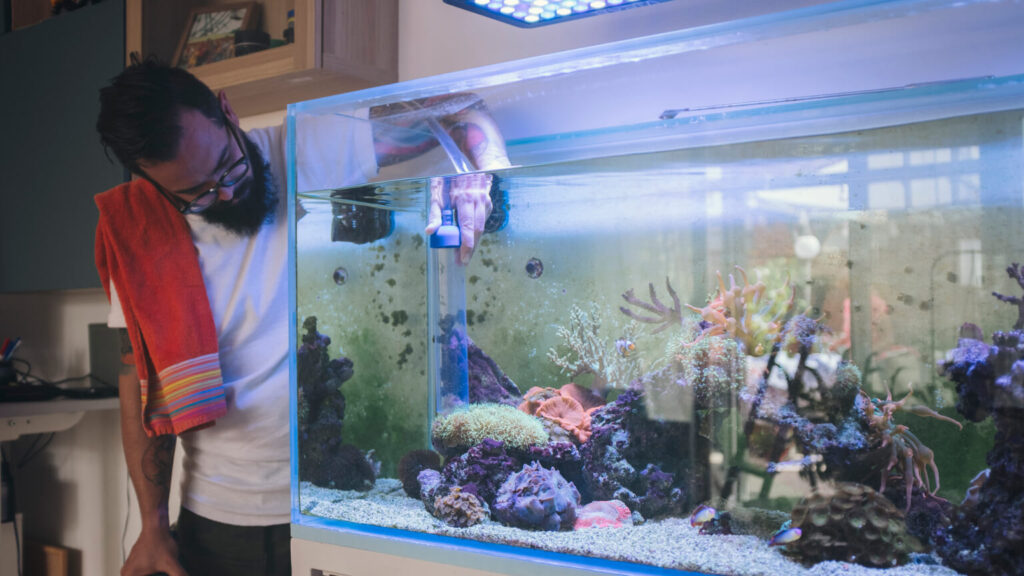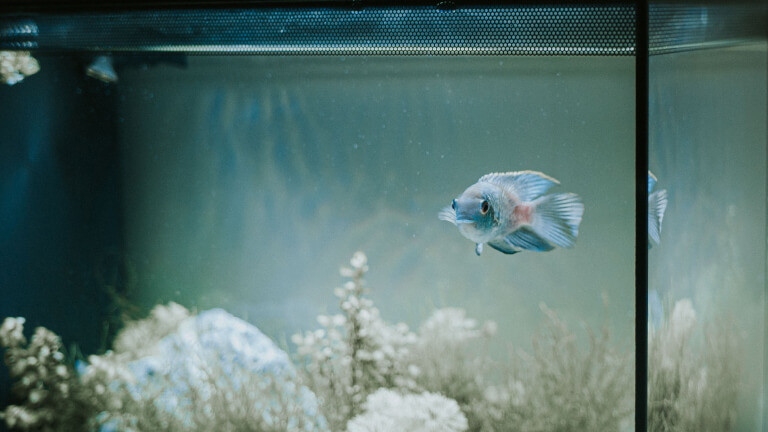How to Successfully Move With Fish

The products featured here are independently selected based on thorough research from our editorial team. If you buy something through links on our site, we may receive a commission.
Moving with fish is different than moving with a cat or dog. Instead of packing up a pet bed, some food, and a few toys, you’ll be moving an entire ecosystem and a large glass box. Whether you’re moving across states or around the block, fish survival is the name of the game.
There are a few things you should do to make sure your fish and their habitat survive the journey to their new home. Sound stressful? Don’t worry, I’ll show you how to easily prepare and move your fish step-by-step.
Gather your supplies
You know what they say – preparation is key! Before you start the fish-moving process, there are a few supplies you’ll want to keep handy to ensure everything goes according to plan.
- Insulated or styrofoam coolers: carries multiple fish together to save space, helps regulate the water temperature, and move the tank water.
- Large fish bags: used to bag the fish, make sure they have oxygen, and keeps them safe while on the road.
- Rubber bands: seals the fish bags.
- Fish net: catches the fish.
- Aquarium siphon: drains the water from the tank.
- Water conditioner: conditions the new water added to the tank after the move.
- Aquarium salt: helps heal sick and injured fish in freshwater aquariums.
- Blankets and towels: packs the empty fish tank away securely.
- Bubble wrap: protects the outside of the fish tank during travel.
Step-by-step guide on how to successfully move with fish
Step one: prepare fish for transport
Unfortunately, your fish can’t just stand up and walk out the door with you, which means you’re going to need to prepare some fish transportation. It’s best to bag all your fish in separate bags. Bagging fish separately means there’s no risk of contaminating your other fish if one gets sick or dies during transport. Plus, you won’t have to worry about any bullying between your fish. Styrofoam or insulated coolers help to regulate the water temperature and keep it from making any drastic changes in temperature.
- Sort your fish bags and coolers to figure out which fish needs what size bag and how many fish will fit in a cooler.
- Unplug and remove equipment from the tank.
- Fill your fish bags ¼ of the way with water from the fish tank. Most of the fish bag should be filled with air.
- Use a fish net to catch your fish and place them in their designated bags.
- Twist and seal up the top of the fish bag with a rubber band.
- Place the fish in their bags along the bottom of the styrofoam or insulated cooler.
MYMOVE pro tip: Avoid stacking fish on top of one another in the coolers – you don’t want to squish them.
Step two: remove everything from the tank
The next step is to pack any plants, equipment, and tank decor. Everything must be removed from the tank, including gravel and sand. Anything left in the tank could potentially damage the seals and glass of your aquarium.
MYMOVE pro tip: Check plants and decor for any hidden fish before packing them up.
Step three: drain and store aquarium water
Once everything is packed away, use your aquarium siphon to empty around 75% of the water from the tank. Empty the tank water into your styrofoam or insulated coolers. It’s best to keep the tank water insulated so that you can reuse the same water at your new destination without giving your fish a temperature shock, which could kill them.
MYMOVE pro tip: try to keep as much of the original tank water as you possibly can. Your fish might not live long enough for you to prep new water for a stable ecosystem.
Step four: pack away the tank
Once the entire tank is empty and dry, fill the tank with soft blankets and towels, and then wrap the tank in a layer or two of bubble wrap. Pack the tank inside a secure cardboard box and place it someplace safe during travel.
MYMOVE pro tip: make sure there aren’t any large gaps in the box where the tank has room to slide around.
Step five: set up the tank in your new home
After you’ve made it to your new home, start to reassemble the aquarium as soon as possible.
- Unpack the tank and inspect it for any cracks.
- Fill the tank with sand or gravel.
- Set up the tank equipment but do not plug them in.
- Fill the tank halfway with the original tank water.
- Place your plants and decor in the tank.
- Add any remaining original fish tank water.
- Introduce your fish back into the tank.
- Top off the rest of the tank with new tank water.
- Add a little water conditioner to the tank to remove any harmful chemicals from the new water.
- For freshwater aquariums, you can add a little aquarium salt. This can help to heal sick or injured fish.
- Wait an hour or two before plugging in the equipment to let everything settle.
- Monitor your fish for any signs of strange behavior.
Important considerations for fish survival

As a fish owner, you know that some fish are quite finicky. Everything in your aquarium is carefully regulated and controlled so that your fish are able to thrive in their environment. Your biggest question is probably something along the lines of “will my fish be able to survive being outside the tank for so long?”
The short answer is yes, and some of your fish may be heartier than they let on. The key to fish survival is knowing what to watch out for, what kind of conditions your fish can survive in, and how long they can survive in those conditions.
There are five considerations to keep in mind when planning out your fish transportation process:
- Water temperature
- Water quality
- Access to oxygen
- Timing
- Fish behavior
Water temperature
Your fish are used to living in a very temperature-controlled environment and it’s best if their water can stay as close to that same temperature for as long as possible. That’s why it’s important to transport your fish in fish bags that are placed inside closed insulated coolers and containers. The insulation helps keep the temperature of the water consistent and ensures that there won’t be any rapid changes in water temperature, which could kill your fish.
After your fish are bagged, you can add a couple of heat packs inside the cooler if you have warm water fish and are really worried about the water temperature.
Water quality
Unfortunately, there’s not much you can control about the water quality when your fish are bagged. Instead, try to focus on the things you can control. The most important thing is how long the fish can live in the fish bag. Your fish can live comfortably in a fish bag for about 7 to 9 hours. If you have a longer drive, don’t stress too much. Your fish should be able to survive a 1 to 2 day trip in a fish bag, but the water quality and oxygen levels will have decreased significantly.
MYMOVE pro tip: fill your fish bags with water from the fish tank. Avoid using any other type of water to transport your fish in.
Access to oxygen
One of the biggest mistakes people make when moving their fish is not giving fish enough access to oxygen. Your fish need access to oxygen to be able to breathe. Without oxygen, they will suffocate and die. The best way to avoid this is by making sure there is plenty of air in their fish bag. The majority of a fish bag should be filled with air. Try to fill fish bags with ¼ water and ¾ air.
Fish use up oxygen faster than you think. That’s why it’s best to bag each fish separately, so they are not sharing oxygen. The more fish in a bag or container, the more oxygen gets used up, and the quicker they die.
MYMOVE pro tip: It’s recommended to buy larger fish bags so that you have more space in the bag for air.
Timing
It’s best to pack away your fish and fish tank the day of your move. This gives them a much higher likelihood of surviving. As stated before, fish can survive comfortably in a fish bag for 7 to 9 hours. Anything longer than that is when your fish’s survival rate starts to decrease. If you decide to pack your fish early, remember that the longer they are out of the tank, the more likely they will die.
If you are making a long-distance move, you could have your fish shipped to your new address if you wanted to. Fish get shipped around all the time. That’s how they get to the pet stores. If there’s limited space in the car or you would rather leave it to the pros, consider shipping your fish with a shipping company that ships live animals.
MYMOVE pro tip: do not feed your fish 24 to 48 hours before your move. The less they’ve eaten, the less waste there will be contaminating their water.
Fish behavior
Another reason why it’s recommended to put your fish in separate bags is to prevent fish bullying. Yes, fish do fight, especially if they are stressed. Lower water quality, less oxygen, or less space to swim can trigger aggression in even the friendliest fish.
Gill and Finny may be BFFs in the tank, but if one of them becomes too stressed, they may start to fight and potentially even try to kill each other. Save yourself a headache (and a few fish friendships) by bagging your fish separately.
MYMOVE pro tip: Keeping your fish in the dark can help to calm them and reduce stress.
The bottom line
Moving your entire aquarium can be a bit stressful, but with the right preparations and know-how, it’s not too scary. Once the move is over, you get to enjoy the best part about being a fish owner – simply watching your fish.



